|
de Havilland
Sea Vixen FAW.1
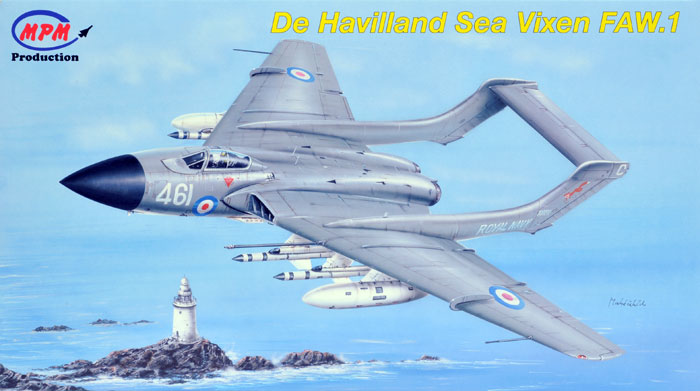
MPM, 1/72 scale
S u m m a r y |
|
Catalogue Number: |
MPM kit number 72545 -
de Havilland Sea Vixen FAW.1
|
|
Scale: |
1/72 |
| Contents and
Media |
Kit: around 70 parts arranged on four sprues of grey styrene; six parts on transparency sprue; sixteen resin parts; canopy masks; decals for two subjects.
|
| Review Type: |
FirstLook |
| Advantages: |
Exquisite moulding with finely engraved panel lines and control surfaces. Lovely resin details. Excellent decals. Type long desired by FAA modellers. |
| Disadvantages: |
No locating/alignment pins for the major parts of construction. Firestreak missiles not included. Slightly undersized seats. Some modelling experience will be required |
|
Conclusion: |
A finely produced mainstream 1/72 Sea Vixen FAW.1 |
Reviewed by Peter Mitchell

MPM's 1/72 scale Sea Vixen is available online from Squadron.com
When Gerry Anderson, creator of the Thunderbirds, was designing the fantastic vehicles featured in that series, I wonder if it is possible that he was inspired by some of the then current RAF/RN jet aircraft? Perhaps it’s just me, but I’ve always thought that Thunderbird 1 had more than a passing resemblance to the E.E. Lightning and that Thunderbird 2 (my particular favourite) must have had its genesis in the de Havilland Sea Vixen.
The Sea Vixen was the final development of de Havilland's response to Specifications N.40/46 and F.44/46 for an all-weather, missile-armed, high-speed jet fighter.
The other contender for this requirement was the Gloster Javelin.
In the end the RAF chose the Gloster product, while de Havilland won over the navy.
Things did not get off to a good start for the Sea Vixen.
The first prototype, the DH 110, tragically disintegrated at the 1952 Farnborough Air Show killing its crew and twenty nine spectators.
Following an investigation and some design modifications, a strengthened prototype resumed the development of the project.
The first true Sea Vixen had its maiden flight on 20th June 1955 and by 1956 it had conducted its full sea trails on HMS Ark Royal.
The Sea Vixen used the same twin tail boom arrangement as that used on its predecessors the de Havilland Vampire and Venom, indeed the Sea vixen resembled a Venom on steroids.
Crew arrangements on the Sea Vixen were slightly unorthodox, The pilot sat in a cockpit with the canopy offset to the left hand side, similar to the E.E. Canberra PR 9, while the navigator/observer was housed to the right completely within the fuselage down the "coal hole" which only had a small window.
First produced as the Sea Vixen FAW.1, this was succeeded in 1962 by the Sea Vixen FAW.2 which had improved electronics, crew escape systems and greater range. The extended range came from additional fuel stored in tanks housed in enlarged tail booms fitted above and before the wing leading edge.
Visually an FAW.1 and FAW.2 may be distinguished by these tail boom fuel tanks which extend forward over the leading edge of the wing on the FAW.2.
The Sea Vixen was to become the first British aircraft to be solely armed with missiles, rockets and bombs.
During its service career, the Sea Vixen flew with eight squadrons of the Fleet Air Arm until 1972, when they were eventually replaced by the McDonnell Douglas Phantom. The last remaining roles for the Sea Vixen in service was that of a target tug, the TT.2 and as a Drone the D.3 which flew on into the 1980’s.
Many examples of retired Sea Vixens escaped the scrap yard and are now to be found in museums.
Currently there is only one example XP924 that remains in flying condition.
MPM has just released a 1/72 scale Sea Vixen FAW.1. This kit contains essentially the same excellent plastic and resin parts as the Xtrakit Sea Vixen Sea Vixen FAW.2/D 3 released in June of this year, with the exception of the large overwing tanks. This new 1/72 scale MPM kit also provides self-adhesive canopy masks.
MPM's 1/72 scale Sea Vixen FAW.1 comprises four sprues of light grey styrene, minimal flash and exquisite surface detail. Sprue attachments are thin and sensibly placed, although there are some ejection pins that will need to be removed to ensure some larger parts fit together; but nothing that damages any detail or will be seen after construction.
Construction starts, as you might expect, with the cockpit.
Here MPM has provided all the basics and then a little more. The cockpit tub is divided into pilot and observer sections, detailed side consuls are then added, as are two nicely detailed instrument panels.
These are then supplemented by two beautifully moulded resin MB Mk.4D ejection seats complete with seat harnesses. The seats are slightly undersized - around 1/87 scale. Apparently this was an intentional compromise to permit more detail to be present on the various panels.
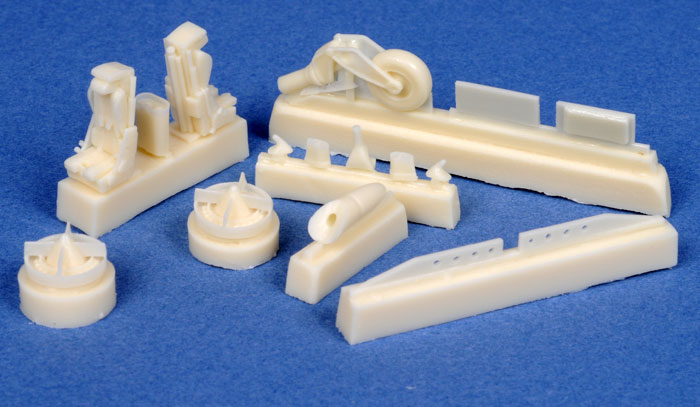
There is room for further detailing should the modeller wish to go down this path; however one must remember that the cockpit openings are not large and the predominant colour will be black.
The rear of the Rolls Royce Avon engines are provided as fine resin mouldings and these are engineered to slip into the end of the exhaust nozzles. Air intake ducts are provided and these are blanked off at the end by nicely represented engine turbine fronts.
The fuselage is split horizontally and extends along the wing to include the tail boom faring and inner wings. The top and bottom halves sandwich in the cockpit, enclosed wheel wells and engine ducts.
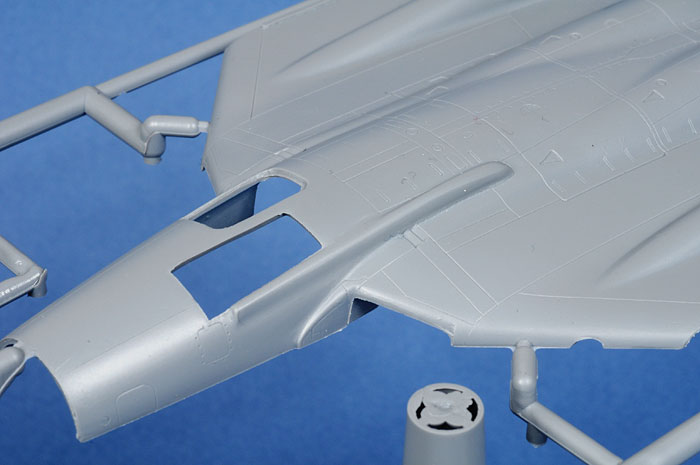
The tail booms and outer wing panels butt join to the main fuselage assembly, and this is perhaps the main weakness of the kit, since there are no alignment pins or tabs. It will in all probability be a little tricky to get the correct alignment and these critical joints will be weak. I feel that the modeller cannot avoid adding some extra strengthening pins in this area. Even so, by leaving the outer wings as separate panels it will enable the modeller to produce the kit with the wings folded. The attachment ends will need to be detailed and I expect that some enterprising after-market manufacturer is already working on resin replacements.
The nose is a separate item and attaches to the fuselage at a natural break, no doubt the same enterprising after-market manufacturer will provide the necessary radar installations that will enable this to be displayed in the open position.
No mention is made in the instructions concerning the need for nose weight and I would have expected that the Sea Vixen would be a tail-sitter. Nevertheless, there ought to be sufficient space in the nose for this to be included and I will certainly be adding it to mine….. just to be sure.
The final part of construction concerns the addition of the tail boom extensions, various fins, antennae, intakes and the landing gear. The forward landing gear is a delicately moulded resin item. In providing the tail boom extensions as separate items the mould designer has cunningly enabled this kit to model either the FAW.1 or FAW.2 versions.
The option of a leading edge refuelling probe is included, as is an extended or retracted arrestor hook.
Ordinance attachment pylons are provided, however the only ordinance included with the kit are outboard wing drop tanks (Firestreak missiles are illustrated on the box top but not supplied in the kit). Interestingly these attachment pylons are about the only kit items I could find that have any shrinkage dimples in them and these are only slight!
The kit transparencies are clear and commendably thin they include windshields for both the FAW.1 or FAW.2 versions and will enable both pilot and observer cockpits to be displayed in the open position.
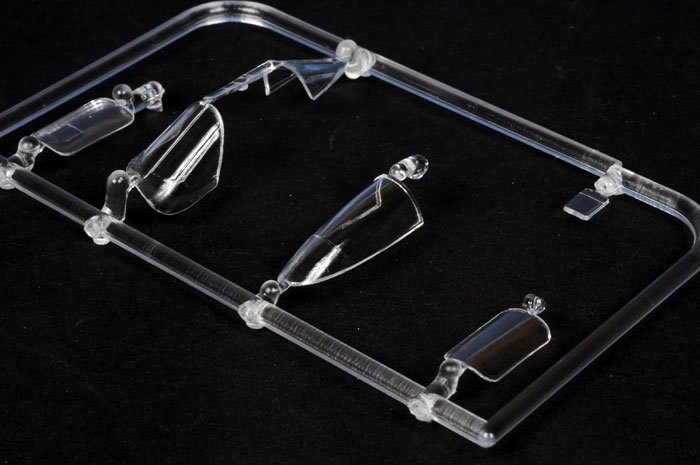
The decals are beautifully printed by AVIPRINT. They are very comprehensive, providing a plethora of stencils, the detail is fine enough for even the small print to be legible. The colour grades appear to be correct and the register is perfect.
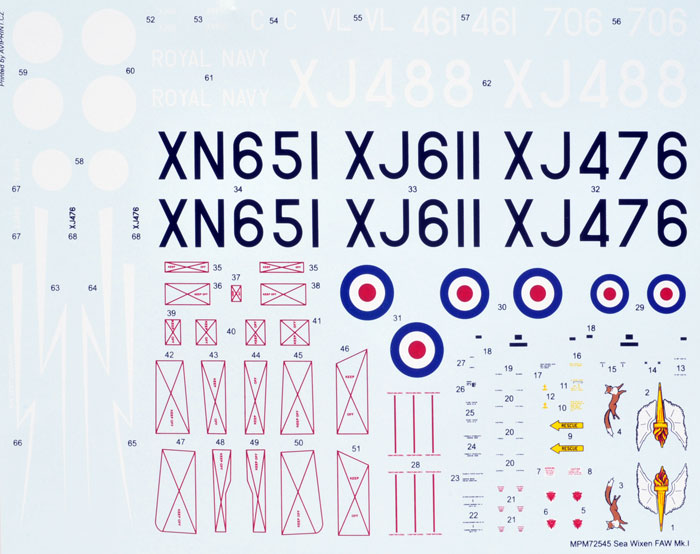
The modeller is offered the choice of four markings - three in the usual grey and white, and one in overall white.
Overall, this is a gorgeous kit that should satisfy the majority of modellers and will be suitable for all but novice levels. It is high quality and enough is included to make a pleasing model straight from the box, while those with a super-detailing fixation should be able to make a masterpiece without too much trouble.
We now have a finely produced mainstream 1/72 Sea Vixen FAW.1 to join the earlier Xtrakit FAW.2.
Thank you MPM!
Thanks to MPM for the sample
References
-
Xtrakit instruction sheet
-
Wikipedia: Sea Vixen
-
Scale Aircraft Modelling Vol. 18, No. 8. October 1996 p390-392.
-
Model Aircraft Monthly Vol. 4, Issue 3. March 2005 p46-55.
-
“Warpaint No. 11” by Steve Hazell. Hall Publications
Text Copyright © 2008 by Peter Mitchell
Images Copyright © 2008 by Brett Green
This Page Created on 18 December, 2008
Last updated
18 December, 2008
Back to
HyperScale Main Page |
